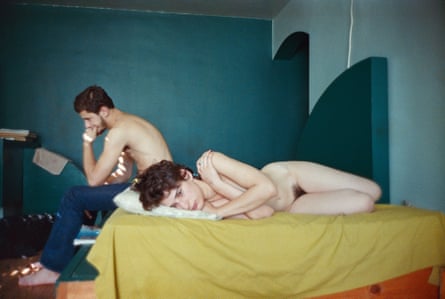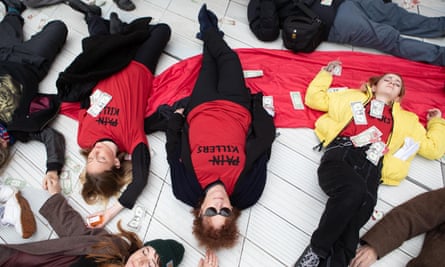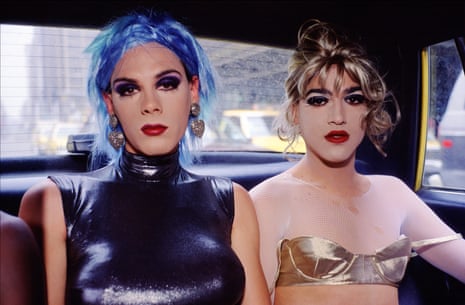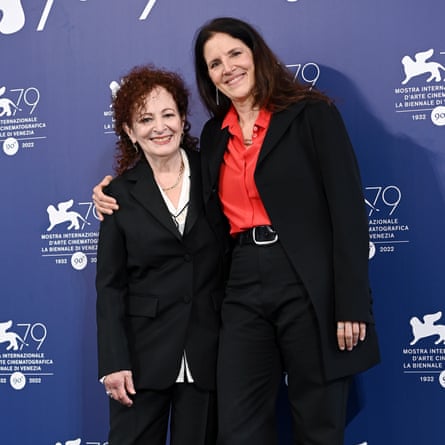In September 2016, I met with Nan Goldin in C Wing of Reading Gaol. She was there alongside several other artists at the invitation of Artangel, the London-based organisation that specialises in often ambitious site-specific installations. The ensuing group exhibition paid homage to Oscar Wilde, the prison’s most famous inmate, whose writings Goldin first encountered as a teenager. The message she took from his life and work, she told me, “is that you can remake yourself completely.”
Since then, that is in effect what she has done, becoming a high-profile activist who has used her status as an artist to radically change the landscape of the American and European art world. Goldin’s much-publicised war on the billionaire Sackler dynasty, whose company, Purdue Pharma, fuelled the deadly opioid epidemic in America, has resulted in the family’s name being removed from a raft of major galleries and museums, including the Tate, the Louvre and the Guggenheim. For a long time, the Sackler name was a byword for almost unparalleled philanthropy and largesse towards the arts; it is now synonymous with shame and misery on an even grander scale. “If that’s what a group of 12 people can do,” says Goldin, referring to the friends and assistants who form the core of her small, but dramatically effective, organisation, Pain (Prescription Addiction Intervention Now), “then anything is possible.”
Goldin’s transformation from artist to activist is brilliantly traced in a new documentary feature film, All the Beauty and the Bloodshed, which won the Golden Lion at this year’s Venice film festival. It is directed by Laura Poitras, who is best known for her Academy Award-winning 2014 film Citizenfour, about the American whistleblower Edward Snowden. Poitras deftly weaves Goldin’s activism into the bigger story of her life and art, including the rawly intimate photographic projects such as The Ballad of Sexual Dependency and Sisters, Saints and Sibyls, that reflect how deeply the two are intertwined. From the off, her photography drew directly on her life and her circle of friends: bohemians, transexuals, addicts and fellow self-made artists in her native Boston and later in New York. Her style, often described as diaristic, has been enormously influential and made her one of the world’s most famous photographers, whose work now resides in prestigious museums and collections around the world.
Goldin’s anti-Sackler campaign was already well under way, and being documented by an assistant, when Poitras came on board in 2019. “A producer said to me, ‘If you want this to be seen, you need a name director,’” explains Goldin. “He put me in touch with Laura and it was a good call, even though it was hard at times for me and her to work together. We’re two strong women who are not used to anyone saying no to them. It was difficult at times, but we’re still friends.”

I ask Poitras if she had any reservations about taking over the project. “Apart from being a little intimidated by Nan herself, no,” she says, laughing. “She is definitely a formidable presence, but as soon as she told me about the project, I volunteered. This was essentially a story about an individual taking on the big forces of power and that is exactly the kind of subject I’m drawn to.”
Poitras describes Goldin as “a no-bullshit person” and says she admires the artist’s almost reckless approach. “There’s a rawness and a drive to what she does. She’s not calculated. If she decides something has to be done, she finds a way to do it and worries about the possible consequences later. Here is an artist using her position in the art world to try to hold this family accountable. I just wish more people would use their power in that way.”
When we chatted outside Oscar Wilde’s prison cell on that afternoon in 2016, though, Nan Goldin did not seem focused or driven. As she talked me through her installation of photographs and videos, she appeared at times distracted and edgy. When I accompanied her outside into a courtyard for a cigarette break, I asked her outright if she was using heroin again – Goldin had struggled with addiction in the late 80s and we had talked about it in the past. She shook her head and said, “No, it’s Oxy.”
It was the first time I had heard the street term for OxyContin, the prescription painkiller mass-produced and marketed by Purdue Pharma that would soon become one of America’s biggest news stories as addiction rates and deaths by overdose soared to unprecedented levels. Goldin had been prescribed it in 2014 in Berlin before surgery for tendonitis in her left wrist and had become addicted. When we met in Reading, I was unaware of the burgeoning opioid crisis and assumed that she was probably in denial about relapsing into heroin use and was spinning a cover-up story, as users often do.
“Well, it was junkie bullshit in a way,” she says now, laughing, when I mention my misplaced scepticism. “Oxy is a good drug for surgical pain, but it’s basically dope in a pill and I got addicted really fast. You recognised what was going on, but it took me another year to go into rehab.”
Back in the 80s, Goldin tells me, it had taken her a long time to become a heroin addict, but with OxyContin, she was hooked in 48 hours and, within two weeks, was taking 15 pills a day. When she returned to New York, she quickly found a dealer who was on call 24 hours a day. Soon, she was crushing the pills and snorting them through a straw, only rarely leaving the house and seldom moving from her bed. “It’s scarily addictive,” she says, “particularly for someone with a history of drug use, who has what they call opiate receptors’ effect left over from before. OxyContin attaches to your brain immediately. That’s what happened with me.”

In a now-famous open letter to the Sacklers published in Artforum in January 2018, after she had recovered, Goldin wrote, “I survived the opioid crisis. I narrowly escaped.”
She went on to explain that, at one point in her addiction, she had ended up snorting fentanyl (a powerful synthetic opioid that is up to 100 times more powerful than heroin) and overdosed. Incredibly, she had somehow managed to produce work during her lost years, including the Artangel commission, and had even carried out a few public engagements. “I remember meeting you that time, but I have a lot of brown-out from that period,” she says now. “Not a total black-out, but close. When I was in the rehab clinic, a woman came to visit and she said, ‘Oh, Nan, I really liked your New Yorker talk.’ I had absolutely no memory of having done a public talk for the New Yorker. None. Which is kind of scary.”
Today, Goldin is speaking to me over Zoom from her apartment in Brooklyn, where she has lived for the past eight years or so, surrounded by photographs by friends such as the late Peter Hujar – “the stillness and depth of his work is unsurpassed” – and some unsettling taxidermy specimens including a fierce-looking coyote that stands sentinel at her door. Goldin, who is 69, looks healthy and speaks thoughtfully, and with her customary honesty and the occasional flash of anger. “All the time I was on Oxy, I was not even aware there was an opioid crisis in America,” she says. “I had no idea. I didn’t keep up with the news. I was totally hermetic. I didn’t know shit.”
It was while in recovery in a rehab clinic, under the care of the same doctor who had weaned her off heroin in 1989, that she first began to wake up to the scale of the problem. A pivotal moment for her was reading Patrick Radden Keefe’s long and detailed New Yorker story on the Sacklers, The Family That Built an Empire of Pain, in October 2017. (The article was a precursor to his acclaimed book, Empire of Pain, published last year.) It begins by documenting the history of the family’s extravagant art world philanthropy, before shifting focus. “The bulk of the Sacklers’ fortune has been accumulated only in recent decades, yet the source of their wealth is to most people as obscure as that of the robber barons,” he wrote, before citing Purdue Pharma as the source of their billions.
Then came the statistics: between 1999 and 2017, 200,000 deaths had occurred from overdoses of OxyContin and other prescription opioids; at the time of writing, around 145 people were dying every day from opioid overdoses; four out of five Americans who had been prescribed prescription painkillers were now using street heroin. “The sheer scale of what was happening seemed almost unbelievable,” says Goldin, “but Patrick’s article gave me a sense of purpose and showed me how to go forward.”
In Poitras’s deftly structured film, we see the Pain campaign grow and its interventions become more audacious: a mass die-in at the Met as pill bottles floated in the gallery fountain; fake prescriptions falling like snow from the upper walkways of the Guggenheim. The latter action is almost an art piece in itself, a subversive take on a now-infamous phrase used by Richard Sackler at a launch party for OxyContin, in which he predicted that “a blizzard of prescriptions” would follow. We also witness the celebrations – cheering, cakes and impromptu speeches in Goldin’s living room – as, one by one, the art institutions cave in to the pressure of the protests and the welter of press coverage they attracted.
Some took longer than others: London’s Victoria & Albert Museum held held out until October of this year. “I was so happy about that,” says Goldin, “because it looked like they were never going to do the right thing.”
Does she now feel differently towards the art establishment given its collusion with the Sacklers? “Well, if you scratch the skin of any billionaire, there are usually bodies behind their money. I mean, name one ethical billionaire? It’s hard to. And the boards are still full of those people. The fact that there is pretty much no state or federal help for museums means they are dependent on these people. Plus, there is dirty money everywhere. But, I have to say, I still love museums. In the end, most of them did the right thing and hopefully we have at least started a conversation.”
Did she ever feel that she might be ostracised by the art world for her high-profile activism? “It’s funny, because people have said to me, ‘How could you do that? Didn’t you think about how it might affect your career?’ I guess I may have spent a few minutes thinking about it. I suppose the fear was that I could have been erased somehow and it’s probably true that I was not invited into exhibition in those years. Right now, I have a big retrospective in Sweden and there are museums that we thought might want it, but don’t. I don’t know if that’s related to me now being seen as a trouble-maker.” Wasn’t she always seen as a bit of a trouble-maker? “Yeah, but before they probably thought I was too fucked up to be dangerous.”
Throughout Poitras’s film, the Sacklers remain an invisible presence until a riveting scene in which Goldin and her fellow activists are gathered around a screen to watch a remote federal court proceeding in which board members Theresa and David Sackler listen impassively to the testimonies of those who have lost loved ones to OxyContin. Under court rules, they could not respond and had to sit silently while roughly two dozen people gave emotional statements. “I am one of the survivors of your monumental greed,” says one man. “I hope that every single victim’s face haunts your every waking moment, and your sleeping ones too.”
At one point, a recording of an emergency ambulance call is played and the camera captures the silence in the room as Goldin and her friends listen to a panicked father’s frantic phone conversation with the emergency service, while his distraught wife screams in the background. They had just discovered their 20-year-old son on the floor, unconscious and unresponsive following an overdose of OxyContin. The tape is followed by the parents’ video testimonies, a glimpse of the well of sorrow and grief that opened up with the death of their only child. “I want to point out to the Sacklers,” the father says, in conclusion, “that, by the time this two-hour hearing is over, you can add 16 more people to your death list.”
It is a viscerally powerful moment in a film not short on drama, and one made all the more disturbing by the silence of the accused. “Richard Sackler refused to come on screen and I don’t know how he got away with that,” says Goldin, angrily. “The other two just sat there. David had this moronic, depressed look. Theresa, she didn’t blink. It was as if she was listening to something mildly interesting that did not affect her reality.” She pauses for a moment. “There was not one iota of empathy in this family for other human beings. That’s what astounds me. How can you live without any empathy for other people?”

As yet, none of the Sacklers has been held to account for the havoc that OxyContin wreaked on America. Goldin shakes her head as if still in disbelief when I mention this. “At least they are shamed,” she says. “That was my first goal: to shame them among their peers in order to put pressure on the museums. But I must have been naive to think anyone from that family was gonna flip and talk to us or do the right thing on any level. They are born entitled and they live in a cocoon of wealth. They are not aware of the rest of the world at all.”
Poitras describes All the Beauty and the Bloodshed as, on one level, “a window into the brutality of American capitalism”. “Oh my God, totally,” says Goldin. “And there is no accountability for rich people. All these billionaires are protected by huge legal teams and they pump money into the state and the congress so that laws don’t get changed. Doesn’t matter who is in power, Republicans or Democrats, America is totally broken and it’s scary.”
As its title suggests, though, All the Beauty and the Bloodshed is not just a film about one woman’s fight against a powerful global corporation, it also traces Goldin’s singular life as a transgressive artist as well as her troubled youth in suburban Boston and the wildly dissolute downtown scene she gravitated towards on her arrival in New York. As she has said before, photography saved her life, but it also turned her life, and the lives of those around her, into a new kind of intimate visual poetry: raw but tender, unflinching but vulnerable.
Her earliest realised work, The Ballad of Sexual Dependency, remains her most celebrated. It was originally shown by her as a slideshow with an ever-evolving soundtrack – the Velvet Underground, Charles Aznavour, camp show-tunes, breathtaking arias – at loft parties and in downtown dives. The audience back then was mainly comprised of her dissolute friends – fellow struggling artists, hustlers, transvestites and other outsiders – but, in 1985, it caused a big stir at the Whitney Biennial and the rest is history.
Its gestation is traced early on in All the Beauty and the Bloodshed, as Goldin recalls the wild times over her archive footage of the friends and fellow travellers she has helped immortalise in her work: the underground actress Cookie Mueller; photographer David Armstrong; artist, writer and Aids activist David Wojnarowicz, as well as the transsexuals, outsiders and scenesters of another scuzzy, less corporate era in downtown Manhattan. There is a moving section on the many friends she lost during the Aids crisis in the 1980s and an acknowledgment of the huge influence the Act Up activism campaign of that time had on the tactics employed by Pain. There are one or two personal revelations, including Goldin’s decision to talk about the time she became a sex worker to pay the rent. “I don’t have many secrets in my life, but this is one of them,” she tells Poitras, describing it as “one of the hardest jobs you could have”. Was Poitras surprised by the extent of her openness? “I just thought it was so very brave. It’s not looking for attention, it’s not about her; it’s about the importance of addressing these almost taboo issues. Plus, I think she made a decision that it was time to talk about some of these very intense and personal subjects.”
Some of the most poignant moments in the film address Goldin’s troubled childhood and the circumstances of her beloved sister, Barbara’s suicide, aged 19. Nan was born Nancy Goldin, the youngest of four children, to Jewish parents in Lexington, a middle-class suburb of Boston. Her father was an economist, her mother a housewife, and their dedication to maintaining a veneer of utter respectability despite myriad family rows and simmering generational tensions seems to have created a stifling atmosphere that fuelled her older sister’s rebellion. “My sister taught me to hate suburbia from a very young age,” Goldin told me in a previous interview, “the suffocation, the double-standards. ‘Don’t let the neighbours know’, was the gospel. Well, the neighbours certainly knew what was going on in our house, because they heard it at every turn.”

I tell her that I was surprised at how open she was in the film about the one subject – her family and, in particular, her sister – that she has previously been reluctant to talk about. “I know, and that was painful, very painful,” she says, quietly. “I gave those interviews on the condition that I would have some control over them, otherwise I would not have done them. Then, when I finally watched the film in May of this year, when it was very nearly a final cut, I really didn’t like how it came across at all. I re-edited it so that it is my voice speaking my truth in a way that is as accurate as can be. It had to be accurate to what I wanted to say.”
What did she want to say exactly? “I just wanted to tell my truth,” she replies, echoing Poitras. “And it’s also my desire to help eradicate the stigma around subjects like suicide, as well as drug use and prostitution – all of that stuff. But it’s also important to say that, when I do the work, it’s not coming from that instinct. That’s not where the work comes from at all. It’s something that comes much later, perhaps as a result of doing the kind of work I do.”
Using the artist’s rich trove of personal material – family photographs, grainy home movies, snapshots – the sections that Poitras shapes around Barbara’s death are deeply moving, not least because Goldin’s love for her older sister who, she says, “parented” her, is palpable. Likewise the sadness she still feels all these years later. In Goldin’s telling, Barbara was essentially too rebellious for her parents to handle. “She had a wildness to her,” she tells Poitras in the film, before describing her parents’ attempts to quell it by exiling her sister in various mental institutions from an early age. “Once they started sending her away, they kept sending her away,” she says. “They silenced her.”
For all that, in the footage of her family made in the years after Barbara’s death, her father seems so deeply affected by the suicide that he has retreated into silence. In one image Goldin made of him, he is sitting with a dark sheet over his head. His sadness is made all the more telling in contrast to his wife’s forced gaiety.
“My father was much more deeply affected.” says Goldin. “He was depressed for the rest of his life and very guilty about what had happened. Never got over it. And he lived till 99, so he had a lot of years to experience those feelings. My mother was more cut off in a way.” She falls silent for a moment. “But, you know, they both came from extreme poverty. And they had children because that’s what people did back in those years. They really weren’t meant to be parents. Mind you,” she adds, chuckling, “most people aren’t meant to be parents.” Does she think one ever really escapes one’s childhood? Another pause. “Yes. I think so,” she says, nodding but looking a little uncertain. “I think so.”
All the Beauty and the Bloodshed, then, is a Laura Poitras film, but it is also quintessentially a Nan Goldin film: brutally honest, deeply poetic. It is freighted by great loss: lost friends, lost family, the lost years of drug addiction, and by Goldin’s encroaching sense of her own mortality. “I think that people who make stories out of their lives tend to repeat the stories over and over again,” she says, towards the end of our conversation. “But it’s not easy to access the real deep stuff, the real memories. As you get older, those memories keep coming back to you and they can take you by surprise because you don’t know when they will come back. And, unlike stories, you can’t tie them up in a tidy ending.”
Recently, when Goldin attended the opening of the current retrospective of her work, pointedly titled This Will Not End Well at the Moderna Museet in Stockholm, she was taken by surprise by the sheer number of images in the various slideshows. “I realised there were around 2,000 pictures. And I’m thinking, who the fuck took all these pictures? How could one person have taken them all? I just lived so many lives, I guess. Some, I don’t remember at all, but there’s a lot I do remember.”
Does she remember the people and places in the photographs because of the photographs? “That’s such an interesting question,” she says, “I’m not sure. I don’t think so. I mean, with the Ballad…, it’s full of people who died. And it’s the same with the queens and trans people I photographed back then. So many of them have died. It’s kind of like I have embalmed them for myself. I’m somehow keeping them with me through the pictures. And I’m also keeping them young and beautiful. Most of the people around me are younger, because I don’t have a lot of people to get old with. If they were still around, I probably wouldn’t recognise most of them now. But, with the photographs, it’s always the way they were.”
I ask her, in conclusion, if her activism has profoundly changed her as a person? “Yes, it has,” she answers immediately. “I feel more present in the world. It’s still a scary place, but it doesn’t scare me as much any more.” And is she less angry at the world now? “Oh yeah. Much less. I still get angry and when I do, I get real angry. I’m still a bitch at times. And, I’m still a fighter.”






